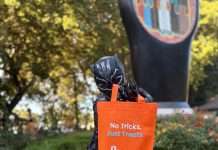 So you have a new baby, and while you expected there to be a period of recovery while your body heals from the birth (or just from the sheer exhaustion of those early days), you probably didn’t expect your wrists to hurt so darn much. You’ve got Mommy Wrist (sometimes called Mommy Thumb), which occurs when we repeatedly torque our wrists and hands in awkward positions to pick up, hold, and nurse our babies. Over time, those tiny motions add up to cause a lot of pain.
So you have a new baby, and while you expected there to be a period of recovery while your body heals from the birth (or just from the sheer exhaustion of those early days), you probably didn’t expect your wrists to hurt so darn much. You’ve got Mommy Wrist (sometimes called Mommy Thumb), which occurs when we repeatedly torque our wrists and hands in awkward positions to pick up, hold, and nurse our babies. Over time, those tiny motions add up to cause a lot of pain.
We asked Dr. Thomas Kim, an orthopedic surgeon, to tell us more about this painful ailment and how to prevent it.
What is Mommy Wrist?
Mommy Wrist is a tendonitis. It is also known as De Quervain’s tenosynovitis. The tendons run in a tunnel, and with overuse, the tunnel and the tendons can become inflamed and irritated. Parents tend to use their wrists and thumbs to hold and lift their children in such a way that cause inflammation of this tunnel and the tendons inside it.
What are the symptoms?
Tenderness and pain at the base of the thumb which is made worse by moving the thumb in a downward flexed position or moving the wrist in a dart-throwing motion. Some patients can have swelling and can even feel a soft globular mass there, which is the inflamed and swollen tissues.
When should a doctor be seen?
When the pain is limiting you from doing things such as lifting up your child or limiting you from performing your work.
What kind of treatment options are there?
The first step is to try anti-inflammatory medications such as ibuprofen, which is safe to take while breastfeeding. You may also try wearing a thumb spica brace that immobilizes your thumb and wrist. For symptoms that are not controlled by this, a steroid/cortisone injection can help tremendously. For recalcitrant symptoms, surgery can be performed to release the tunnel to allow the tendons to glide without friction and pain.
What can parents do to prevent getting Mommy’s wrist?
You can work on strengthening the thumb and wrist with the following exercises. You can perform these without weights initially and then can progress to using some weights when you are more comfortable with the exercises.
Place your hand flat on a table and then gently move your affected thumb up and away from the table surface and slowly bring it back to the table. Repeat 10 times for 3-5 times/day.
[easy-image-collage id=10019]
Place your hand so that your fingers are pointing straight ahead like you’re reaching for a handshake. With your other hand gently lift your affected thumb towards you and then back in line with your fingers. Repeat 10 times for 3-5 times/day.
[easy-image-collage id=10020]
Place your affected wrist and forearm on a table with your thumb pointing upwards. Your hand should be hanging off the side of the table, while your forearm and wrist are supported by the table. Gently lower your wrist downwards below the table edge until you start to feel discomfort. Then use your other hand to bring your hand back up in line with your wrist.
[easy-image-collage id=10021]
Use an elastic band and place your fingers inside. Stretch the rubber band by extending your fingers slowly. Repeat 10 times for 3-5 times/day.
[easy-image-collage id=10022]
[hr]
 Dr. Thomas Kim is an orthopedic surgeon in Greenbrae, California. He received his medical degree from Georgetown University School of Medicine and has been in practice between 6-10 years.
Dr. Thomas Kim is an orthopedic surgeon in Greenbrae, California. He received his medical degree from Georgetown University School of Medicine and has been in practice between 6-10 years.
Dr. Kim completed his orthopedic surgery residency at Johns Hopkins Hospital, consistently ranked the #1 Hospital in the Nation by U.S. News and World Report. At Johns Hopkins Hospital, Dr. Kim received world-class training in all areas of orthopedics. He served as a resident team physician for the Johns Hopkins University NCAA III Athletics and NCAA I Men’s Lacrosse Team.
Dr. Kim then elected to pursue further subspecialty training dedicated to hand and upper extremity surgery at the prestigious Brown University Rhode Island Hospital. There, he trained with some of the top surgeons in the world for minimally invasive surgery of the hand, wrist, and elbow to allow athletes and patients to return to sports/activities quickly.
He has presented numerous scientific papers at national meetings and has been published in multiple peer-reviewed journals. He has also co-authored several book chapters in medical textbooks on hand and upper extremity surgery. He has traveled to Honduras as a visiting surgeon through Health Volunteers Overseas and continues to pursue work abroad as a volunteer surgeon.
Email: thomasjkim7@gmail.com
Office Location & Contact
California Orthopedics and Spine
18 Bon Air Road
Greenbrae, CA 94904
Hand Surgery at Marin General Hospital





















